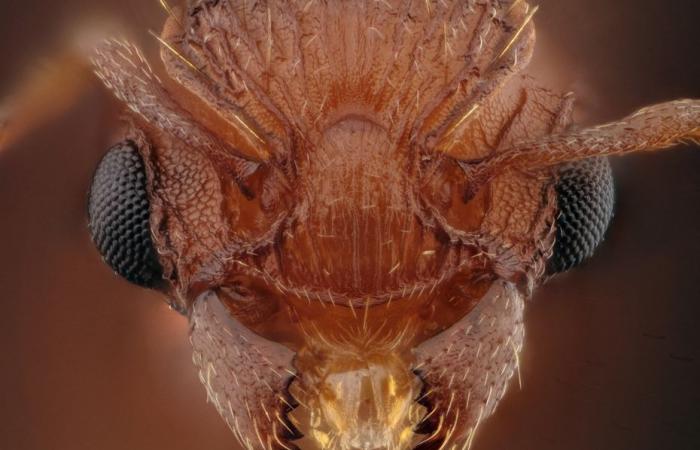
Two years after the detection of a first outbreak in France, “electric ants” were identified in the same department. However, the European Commission requires all national countries to eradicate dangerous invasive species within 3 months of their detection. Explanations.
The essentials of the day: our exclusive selection
Every day, our editorial team reserves the best regional news for you. A selection just for you, to stay in touch with your regions.
France Télévisions uses your email address to send you the newsletter “The essentials of the day: our exclusive selection”. You can unsubscribe at any time via the link at the bottom of this newsletter. Our privacy policy
It all starts at the beginning of summer, a resident of Croix-Valmer in the Var is (again) bothered by ants in his garden. For several years he has suffered from relatively painful bites and irritations which last a little too long for his liking.
This July, he gets a little more annoyed and goes looking for information on the internet. He watches a video made by two ant specialists. Luc Gomel, general curator of heritage attached to the Paul Valery University of Montpellier and Olivier Blight, researcher at the Mediterranean Institute of Biodiversity and Ecology at the University of Avignon.
He decides to contact them, and sends them photos. The two scientists are almost sure: it is indeed the “electric ant”.
They will have confirmation of this when they go there. The problem is that in France, this is the second identified outbreak of this very aggressive invasive ant. The first outbreak was identified by the same specialists 2 years ago, 53 km away, in Toulon.
“Electric ants” were present in the gardens of a residence, in buildings, and in the surrounding natural environment.
For 2 years, we had been monitoring this region like milk on fire, we feared the existence of other outbreaks.
Luc Gomel, former agricultural engineer specializing in the fight against invasive ants.
Among the 16,000 species of ants present in the world, 31 are considered invasive and five of them very dangerous for biodiversity. Prominently, the “electric ant” or “little fire ant” (Wasmannia auropunctata) », originating from South and Central America.
Be careful, it should not be confused with “the fire ant” (Solenopsis invicta) better known and also originating from South America? The latter was detected in 2013 in Sicily (Italy) and caused very significant damage.
The “electric ant” measures no more than 1.5 millimeters. It is also present in the Caribbean and the Pacific Islands. In Europe, it was discovered for the first time in Spain in 2018. Then in Cyprus and France in 2022. In Toulon.
It is an “invasive exotic species”. The definition was developed by the European Commission for species “introduced accidentally or deliberately into a natural environment outside their original natural environment, with negative consequences for their new environment”. On biodiversity or human health. Or both.
The researcher, Olivier Blight explains that they “have been traveling for a very long time, but their introduction rate has exploded in recent years due to the intensification of trade”.
“Electric ants” represent, first of all, a danger to people.
At La Croix-Valmer in the Var, I put my arm down without paying attention. There were a lot of them stinging me, it was painful and my arm was red. This lasted about 3 hours! The amount of poison is limited, but it is strong.
Luc Gomel, general curator of heritage at Paul Valery University of Montpellier
The greatest risk may concern people allergic to the poison of this ant. Repeated bites could also lead to serious vision problems in pets.
The other big danger is the modification of biodiversity, where they set up their colonies. These very aggressive ants attack all other “local” ants as well as all insects within their reach, spiders, centipedes, etc. What may seem like a trivial change at first, ultimately becomes a real upheaval for ecosystems. By modifying the fauna, they bring about significant and often irreversible changes to the flora.
The transport of seeds, for example, can be significantly disrupted.
The French Biodiversity Office describes the “little fire ant” as a species “particularly adaptable: very mobile colonies and on all substrates, in disturbed or undisturbed environments, opportunistic feeding, and even reproduction by cloning possible in anthropized environments.”
Like other invasive ants, they travel mostly unobtrusively on live potted plants. But also with contaminated transport containers, or human movements.
More confidential, ants are also the subject of international trade on the Internet! Enthusiasts carry out amateur breeding. “If we order “electric ants” in Hawaii and they are delivered by La Poste, there are no possible filters. For the moment, we are raising awareness among amateurs and breeders”.
The number of the latter is not yet significant, but researchers fear that in the coming years this will represent a larger proportion.
A worker ant Wasmannia auropunctata, also called “electric ant” found in the commune of Croix-Valmer (Var), October 2024.
•
© Christophe Pellé
If the “little fire ant” is part of the very closed clan of the biggest invaders on the planet, it is because it has some superpowers. There is no competition between individuals from the same colony, no individual dies on the altar of internal wars. Other ant species may kill each other, which can result in the colony size being reduced. Its nest is nomadic, the ants can then place it in the best possible climatic conditions. Here too, losses are reduced.
In addition, they can also adapt, Luc Gomel tells us “there can be natural selection, which allows genetic adaptation, it takes several generations for it to take place around ten years.”
When insects are transported by humans, outside their natural environment, biological control is used to eradicate them. We look for natural enemies: other insects, parasites, viruses or fungi. It is difficult to handle, sometimes dangerous and not always effective.
We must prevent the remedy from being worse than the disease.
For the “electric ant”, no biological control has proven effective in an outdoor environment.
Luc Gomel.at France 3 Côte d’Azur
No grandma's recipes either. Nor even insecticides, because powders and sprays will not be able to kill at most 5 to 10% of ants found outside the home. It's not enough to kill an entire colony.
There is only one solution to date: toxic bait. For the “electric ant”, it was adapted from that developed in Australia for another invasive species, the “fire ant”. This involves attracting the ants with a protein food that they are fond of, in which there is a quantity of insecticide so small that they cannot detect it. It is the massive ingestion of the pellets that will overcome the colony.
Faced with the increasingly frequent presence of species deemed dangerous for biodiversity, the European Commission has taken action. Since October 22, 2014, it has adopted Regulation No. 1143/2014 which aims to “prevent, reduce and mitigate the adverse effects on biodiversity of the introduction and spread of invasive alien species within the European Union.”
When individuals of an “invasive exotic species” are identified in a territory, Luc Gomel explains to us, the European Commission forces Member States to eradicate them within three months. In the Var, for two years, nothing has been attempted. The French state does not seem ready or organized for this type of action.
So in the meantime, our two specialists are working on their personal time to move things forward. You have to act quickly, the ants are not idle. According to them, given the space occupied by Var households, they have been present for almost 5 and 10 years. But the evidence is lacking. The two myrmecologists know that the colonies of “electric ants” are large by nature and shelter many queens and that they can “bud” easily, that is to say, give birth to other homes. A few dozen meters away, when the ants move only with their legs. Or several hundred meters, if they benefit from rainwater runoff. Endemic development is possible and probable.
IPBES, the United Nations intergovernmental biodiversity platform, created in 2012, issued a report last September dedicated to “invasive alien species”. Researchers highlighted the involvement of these species in nearly 60 % of the extinctions of other species, and had an impact estimated at 85% on the quality of life where they were established.
Biological invasions are a major component of current global change, such as habitat destruction, climate change and overexploitation of resources.
In Europe, the cost of the presence of invasive species ants amounts to 51 billion dollars. These are the impact on crops in agriculture, control and eradication of species.
As an example, the “fire ant” (Solenopsis invicta) is the 5th species with the most economic consequences on a global scale.
Perhaps followed, in the years to come, by the “electric ant”…





